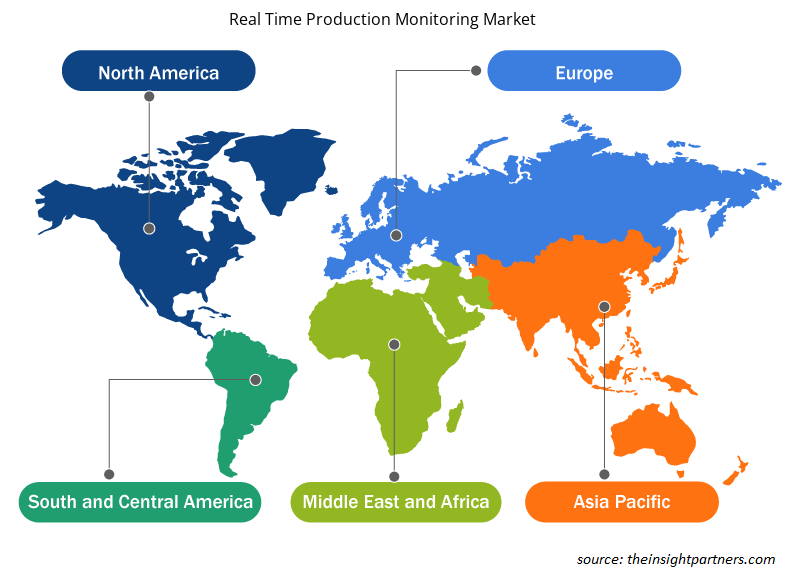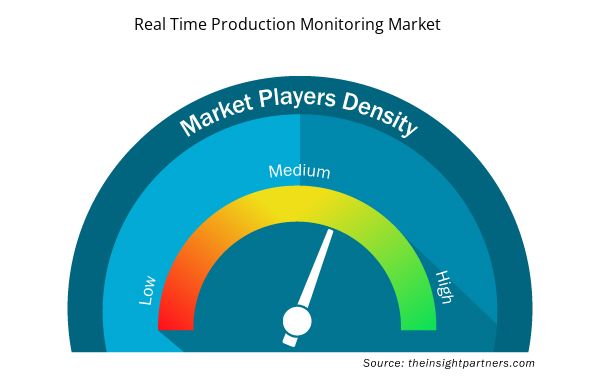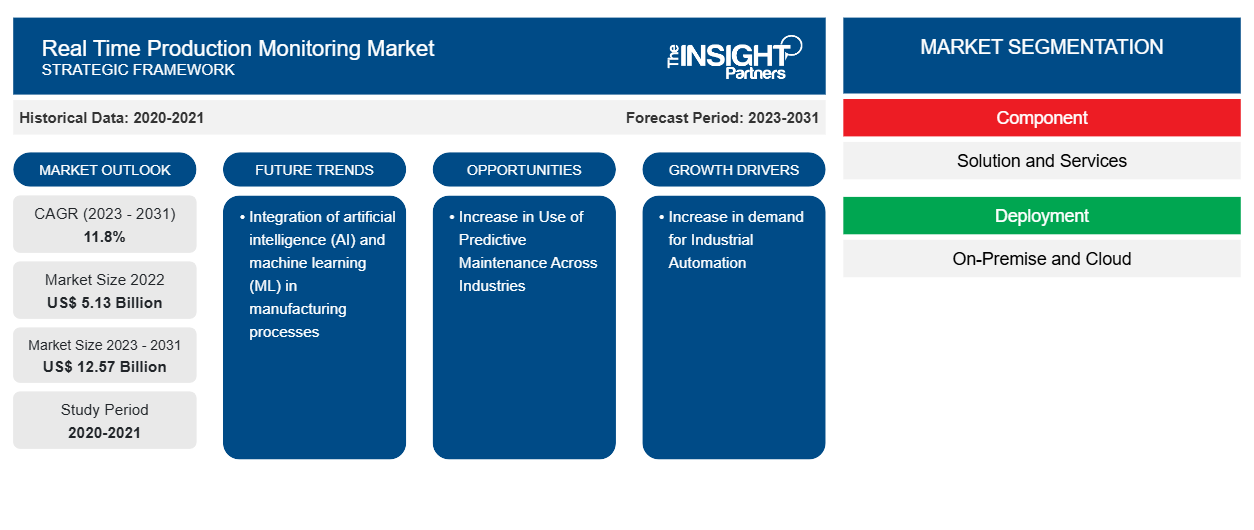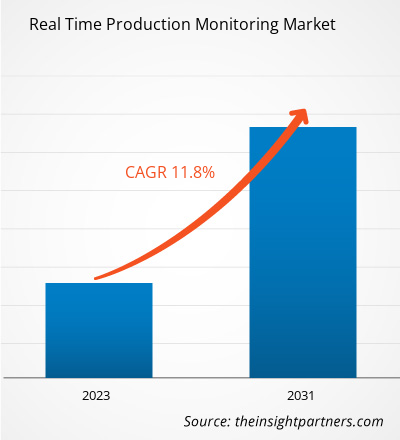リアルタイム生産監視市場規模は、2022年の51億3,000万米ドルから2030年には125億7,000万米ドルに達すると予測されています。市場は2022年から2030年の間に11.8%のCAGRを記録すると予想されています。製造プロセスにおける人工知能(AI)と機械学習(ML)の統合は、今後も市場の重要なトレンドであり続けると思われます。
リアルタイム生産監視市場分析
デジタル製造の需要が高まっているため、市場は着実に成長しています 。製造部門のデジタル化により、製造工程を効率的に管理できるため、メーカーはさまざまなテクノロジーを採用するようになりました。
リアルタイム生産監視市場の概要
リアルタイム生産監視は、生産プロセスの監視に役立つソリューションです。生産パフォーマンスに関するすべての情報をリアルタイムで記録します。監視システムは、製造業者または生産ラインのオペレーターのために、複数の生産ライン ソースから生産データを収集します。収集されたデータは、効率的な生産ワークフローに必要な手順に関する洞察を得ることで、生産ラインの効率を向上させるために活用されます。自動車 、化学薬品、石油・ガス、機械、食品・飲料 などの業界分野で、いくつかの製造業がリアルタイム生産監視市場のこれらのソリューションを採用しています。
要件に合わせてレポートをカスタマイズする
このレポートの一部、国レベルの分析、Excelデータパックなど、あらゆるレポートを無料でカスタマイズできます。また、スタートアップや大学向けのお得なオファーや割引もご利用いただけます。
- このレポートの主要な市場動向を入手してください。この無料サンプルには、市場動向から見積もりや予測に至るまでのデータ分析が含まれます。
リアルタイム生産監視市場の推進要因と機会
産業オートメーションの需要増加が市場を後押し
産業オートメーションは、ロボット、コンピューター、情報技術などの制御システムを使用して、産業内のさまざまな機械を処理し、人間の介入を置き換えます。関連する操作に応じて、 産業オートメーション制御 システムは、プロセスプラントオートメーションと製造オートメーションの2つのタイプに大きく分類されます。産業オートメーションは、新しい革新的で統合されたテクノロジーとサービスを導入することで、生産コストと設計コストを削減しながら、高い製品品質、信頼性、生産率を提供します。これらは、高い生産性、品質、柔軟性、情報の正確さなど、さまざまな機能を備えており、予測期間中に産業部門でのオートメーションの採用が増加する可能性があります。また、石油・ガス、製造、化学・材料、製薬、その他の業界でのオートメーションソリューションの採用の急増は、リアルタイム生産監視市場の成長を促進しています。
業界全体で予知保全の利用が増加
デジタル技術の増加に伴い、多くの製造業が予知保全を活用しています。これらのスマート産業は、製造資産のリアルタイム データを使用し、工場のフロアにあるセンサーが収集する膨大な量のビッグ データを分析します。この分析には、機器のダウンタイムを削減するための予知保全が必要です。リアルタイム生産監視システムは、機器を追跡してアラートを送信できるため、作業は実際に必要な場合にのみ行われます。また、これらのシステムは、標準的なコンピューター保守管理システム (CMMS) と同様の予防保全機能を備えたエンタープライズ リソース プランニング (ERP) システムを 補完するモジュールとして提供されることがよくあります。
リアルタイム生産監視市場レポートセグメンテーション分析
リアルタイム生産監視市場分析の導出に貢献した主要なセグメントは、コンポーネント、展開、企業規模、および業界です。
- コンポーネントに基づいて、市場はソリューションとサービスによってセグメント化されています。ソリューションセグメントは2022年に大きな市場シェアを占めました。
- 展開に基づいて、市場はオンプレミスとクラウドに分割されます。クラウドセグメントは2022年に大きな市場シェアを占めました。
- 企業規模に基づいて、市場は大企業と中小企業に分割されています。大企業セグメントは2022年に大きな市場シェアを占めました。
- 業界別に見ると、市場はプロセス製造とディスクリート製造に分類されます。プロセス製造セグメントは、2022年に最大の市場シェアを占めました。
リアルタイム生産監視市場シェア分析(地域別)
リアルタイム生産監視市場レポートの地理的範囲は、主に北米、アジア太平洋、ヨーロッパ、中東およびアフリカ、南米および中米の 5 つの地域に分かれています。
アジア太平洋地域は、2022年に市場を独占すると予想されています。アジア太平洋地域は長い間強力な製造拠点であり、このセクターは引き続きIoTを積極的に採用しています。IoTは、この地域のさまざまな業界で広く採用されており、デジタルソリューションの採用につながっています。この地域は、製造セクターの強さに大きな可能性を秘めています。2023年3月、ロックウェル・オートメーション社は、第8回年次「スマート製造の現状レポート」の結果を発表しました。オーストラリア、インド、中国、韓国、日本などの国の1,350社のメーカーを対象とした調査によると、APACのメーカーの約44%が今後1年以内にスマート製造を採用する予定であるのに対し、中国のメーカーの約80%、オーストラリアの60%、インドの59%はすでにスマート製造の一部のコンポーネントを使用しています。このように、スマート製造の採用の増加と既存のスマート製造施設は、このソリューションがスマート施設が生産ワークフローをリアルタイムで効率的に管理するのに役立つため、APACでのリアルタイム生産モニタリング市場シェアの拡大を表しています。
リアルタイム生産監視市場の地域別洞察
予測期間を通じてリアルタイム生産監視市場に影響を与える地域的な傾向と要因は、Insight Partners のアナリストによって徹底的に説明されています。このセクションでは、北米、ヨーロッパ、アジア太平洋、中東およびアフリカ、南米および中米にわたるリアルタイム生産監視市場のセグメントと地域についても説明します。

- リアルタイム生産監視市場の地域別データを入手
リアルタイム生産監視市場レポートの範囲
| レポート属性 | 詳細 |
|---|---|
| 2022年の市場規模 | 51億3千万米ドル |
| 2030年までの市場規模 | 125億7千万米ドル |
| 世界のCAGR(2023年~2031年) | 11.8% |
| 履歴データ | 2020-2021 |
| 予測期間 | 2023-2031 |
| 対象セグメント | コンポーネント別
|
| 対象地域と国 | 北米
|
| 市場リーダーと主要企業プロフィール |
|
リアルタイム生産監視市場のプレーヤー密度:ビジネスダイナミクスへの影響を理解する
リアルタイム生産監視市場は、消費者の嗜好の変化、技術の進歩、製品の利点に対する認識の高まりなどの要因により、エンドユーザーの需要が高まり、急速に成長しています。需要が高まるにつれて、企業は提供を拡大し、消費者のニーズを満たすために革新し、新たなトレンドを活用し、市場の成長をさらに促進しています。
市場プレーヤー密度とは、特定の市場または業界内で活動している企業または会社の分布を指します。これは、特定の市場スペースに、その規模または総市場価値と比較して、どれだけの競合相手 (市場プレーヤー) が存在するかを示します。
リアルタイム生産監視市場で事業を展開している主要企業は次のとおりです。
- オラクル
- 株式会社日立製作所
- ロックウェル・オートメーション
- ダッソー・システムズ
- アスペンテクノロジー株式会社
- セダプタ
免責事項:上記の企業は、特定の順序でランク付けされていません。

- リアルタイム生産監視市場のトップキープレーヤーの概要を入手
リアルタイム生産監視市場のニュースと最近の動向
リアルタイム生産監視市場は、主要な企業出版物、協会データ、データベースを含む一次調査と二次調査後の定性的および定量的データを収集することによって評価されます。リアルタイム生産監視市場におけるいくつかの開発を以下に示します。
- ビジネスおよびテクノロジー変革サービスの世界的リーダーであるキャップジェミニと、エネルギー管理および自動化のデジタル変革のリーダーであるシュナイダーエレクトリックは、エネルギー最適化における新たなコラボレーションを発表しました。組織がよりスマートで環境に優しい施設管理とエネルギー効率への取り組みを加速できるように設計されたエネルギーコマンドセンターは、デジタルソリューションと最先端技術の独自のエンドツーエンドの組み合わせを活用して、エネルギー管理を簡素化し、その消費を最適化します。(出典: CAPGEMINI、プレスリリース、2024年5月)
- オラクルは、Oracle Fusion Cloud Applications Suite 内の新しい生成 AI 機能を発表しました。この機能は、顧客の意思決定を改善し、従業員と顧客のエクスペリエンスを強化するのに役立ちます。最新の AI 追加機能には、財務、サプライ チェーン、人事、営業、マーケティング、サービスにわたる既存のビジネス ワークフローに組み込まれた新しい生成 AI 機能と、顧客とパートナーが独自の業界と競争上のニーズをサポートするためにより多くの生成 AI 機能を組み込めるようにする Oracle Guided Journeys の拡張性フレームワークの拡張が含まれます。(出典: Oracle、プレスリリース、2022 年 3 月)
リアルタイム生産監視市場レポートの対象範囲と成果物
「リアルタイム生産監視市場規模と予測(2020〜2030年)」レポートでは、以下の分野をカバーする市場の詳細な分析を提供しています。
- リアルタイム生産監視市場の規模と予測(対象範囲に含まれるすべての主要市場セグメントの世界、地域、国レベル)
- リアルタイム生産監視市場の動向、および推進要因、制約、主要な機会などの市場動向
- 詳細なPEST/ポーターの5つの力とSWOT分析
- 主要な市場動向、世界および地域の枠組み、主要プレーヤー、規制、最近の市場動向を網羅したリアルタイム生産監視市場分析
- リアルタイム生産監視市場の市場集中、ヒートマップ分析、主要プレーヤー、最近の動向を網羅した業界展望と競争分析
- 詳細な企業プロフィール
- 過去2年間の分析、基準年、CAGRによる予測(7年間)
- PEST分析とSWOT分析
- 市場規模価値/数量 - 世界、地域、国
- 業界と競争環境
- Excel データセット


- Arterial Blood Gas Kits Market
- Maritime Analytics Market
- Cell Line Development Market
- Smart Parking Market
- Fishing Equipment Market
- Excimer & Femtosecond Ophthalmic Lasers Market
- Advanced Planning and Scheduling Software Market
- Equipment Rental Software Market
- Energy Recovery Ventilator Market
- Quantitative Structure-Activity Relationship (QSAR) Market

Report Coverage
Revenue forecast, Company Analysis, Industry landscape, Growth factors, and Trends

Segment Covered
This text is related
to segments covered.

Regional Scope
North America, Europe, Asia Pacific, Middle East & Africa, South & Central America

Country Scope
This text is related
to country scope.
よくある質問
Capgemini SE, Oracle Corp, Hitachi Ltd, Rockwell Automation Inc, and Siemens AG are among the leading real time production monitoring market.
The estimated value of the real time production monitoring market is expected to reach US$ 12.57 billion by 2030.
The market is expected to grow at a CAGR of 11.8% over the forecast period.
The integration of artificial intelligence (AI) and machine learning (ML) in manufacturing processes is likely to remain a key trend in the market.
Asia Pacific dominated the real time production monitoring market in 2022.
The market has grown steadily due to increasing demand for digital manufacturing. Digitalization in the manufacturing sector leads to the adoption of several technologies by the manufacturers as it helps manage the production process efficiently.
Trends and growth analysis reports related to Technology, Media and Telecommunications : READ MORE..
The List of Companies - Real Time Production Monitoring Market
- Oracle
- Hitachi, Ltd.
- Rockwell Automation
- Dassault Systèmes
- Aspen Technology, Inc.
- sedApta
- Siemens
- Capgemini
- Infosys Limited
- GE DIGITAL
The Insight Partners performs research in 4 major stages: Data Collection & Secondary Research, Primary Research, Data Analysis and Data Triangulation & Final Review.
- Data Collection and Secondary Research:
As a market research and consulting firm operating from a decade, we have published and advised several client across the globe. First step for any study will start with an assessment of currently available data and insights from existing reports. Further, historical and current market information is collected from Investor Presentations, Annual Reports, SEC Filings, etc., and other information related to company’s performance and market positioning are gathered from Paid Databases (Factiva, Hoovers, and Reuters) and various other publications available in public domain.
Several associations trade associates, technical forums, institutes, societies and organization are accessed to gain technical as well as market related insights through their publications such as research papers, blogs and press releases related to the studies are referred to get cues about the market. Further, white papers, journals, magazines, and other news articles published in last 3 years are scrutinized and analyzed to understand the current market trends.
- Primary Research:
The primarily interview analysis comprise of data obtained from industry participants interview and answers to survey questions gathered by in-house primary team.
For primary research, interviews are conducted with industry experts/CEOs/Marketing Managers/VPs/Subject Matter Experts from both demand and supply side to get a 360-degree view of the market. The primary team conducts several interviews based on the complexity of the markets to understand the various market trends and dynamics which makes research more credible and precise.
A typical research interview fulfils the following functions:
- Provides first-hand information on the market size, market trends, growth trends, competitive landscape, and outlook
- Validates and strengthens in-house secondary research findings
- Develops the analysis team’s expertise and market understanding
Primary research involves email interactions and telephone interviews for each market, category, segment, and sub-segment across geographies. The participants who typically take part in such a process include, but are not limited to:
- Industry participants: VPs, business development managers, market intelligence managers and national sales managers
- Outside experts: Valuation experts, research analysts and key opinion leaders specializing in the electronics and semiconductor industry.
Below is the breakup of our primary respondents by company, designation, and region:

Once we receive the confirmation from primary research sources or primary respondents, we finalize the base year market estimation and forecast the data as per the macroeconomic and microeconomic factors assessed during data collection.
- Data Analysis:
Once data is validated through both secondary as well as primary respondents, we finalize the market estimations by hypothesis formulation and factor analysis at regional and country level.
- Macro-Economic Factor Analysis:
We analyse macroeconomic indicators such the gross domestic product (GDP), increase in the demand for goods and services across industries, technological advancement, regional economic growth, governmental policies, the influence of COVID-19, PEST analysis, and other aspects. This analysis aids in setting benchmarks for various nations/regions and approximating market splits. Additionally, the general trend of the aforementioned components aid in determining the market's development possibilities.
- Country Level Data:
Various factors that are especially aligned to the country are taken into account to determine the market size for a certain area and country, including the presence of vendors, such as headquarters and offices, the country's GDP, demand patterns, and industry growth. To comprehend the market dynamics for the nation, a number of growth variables, inhibitors, application areas, and current market trends are researched. The aforementioned elements aid in determining the country's overall market's growth potential.
- Company Profile:
The “Table of Contents” is formulated by listing and analyzing more than 25 - 30 companies operating in the market ecosystem across geographies. However, we profile only 10 companies as a standard practice in our syndicate reports. These 10 companies comprise leading, emerging, and regional players. Nonetheless, our analysis is not restricted to the 10 listed companies, we also analyze other companies present in the market to develop a holistic view and understand the prevailing trends. The “Company Profiles” section in the report covers key facts, business description, products & services, financial information, SWOT analysis, and key developments. The financial information presented is extracted from the annual reports and official documents of the publicly listed companies. Upon collecting the information for the sections of respective companies, we verify them via various primary sources and then compile the data in respective company profiles. The company level information helps us in deriving the base number as well as in forecasting the market size.
- Developing Base Number:
Aggregation of sales statistics (2020-2022) and macro-economic factor, and other secondary and primary research insights are utilized to arrive at base number and related market shares for 2022. The data gaps are identified in this step and relevant market data is analyzed, collected from paid primary interviews or databases. On finalizing the base year market size, forecasts are developed on the basis of macro-economic, industry and market growth factors and company level analysis.
- Data Triangulation and Final Review:
The market findings and base year market size calculations are validated from supply as well as demand side. Demand side validations are based on macro-economic factor analysis and benchmarks for respective regions and countries. In case of supply side validations, revenues of major companies are estimated (in case not available) based on industry benchmark, approximate number of employees, product portfolio, and primary interviews revenues are gathered. Further revenue from target product/service segment is assessed to avoid overshooting of market statistics. In case of heavy deviations between supply and demand side values, all thes steps are repeated to achieve synchronization.
We follow an iterative model, wherein we share our research findings with Subject Matter Experts (SME’s) and Key Opinion Leaders (KOLs) until consensus view of the market is not formulated – this model negates any drastic deviation in the opinions of experts. Only validated and universally acceptable research findings are quoted in our reports.
We have important check points that we use to validate our research findings – which we call – data triangulation, where we validate the information, we generate from secondary sources with primary interviews and then we re-validate with our internal data bases and Subject matter experts. This comprehensive model enables us to deliver high quality, reliable data in shortest possible time.


 このレポートの無料サンプルを入手する
このレポートの無料サンプルを入手する